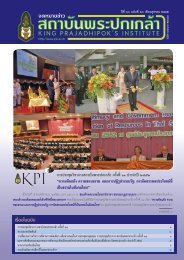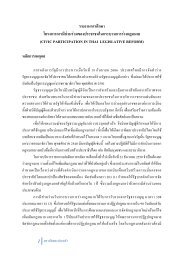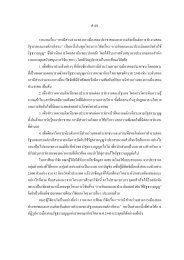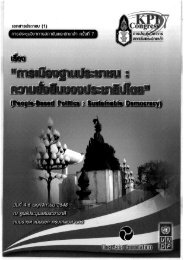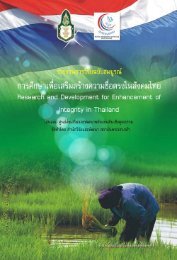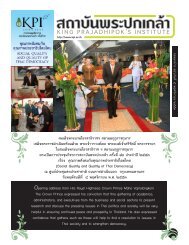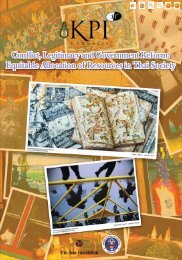SUFFiciENcy EcONOMy ANd GRASSROOtS DEvElOPMENt
SUFFiciENcy EcONOMy ANd GRASSROOtS DEvElOPMENt
SUFFiciENcy EcONOMy ANd GRASSROOtS DEvElOPMENt
You also want an ePaper? Increase the reach of your titles
YUMPU automatically turns print PDFs into web optimized ePapers that Google loves.
The Meaning of Sufficiency Economy <br />
International Conference<br />
195<br />
and Leppin 1991), who considered social support to be the consequences of social<br />
networks, the Thai NESDB integrated social network and social support into their<br />
definition of social capital. The knowledge element consisted of the local<br />
wisdomand the new knowledge(สำนักงานคณะกรรมการพัฒนาเศรษฐกิจและสังคมแห่งชาติ 2548).<br />
The NESDB considered those four elements as Thai society’s assets and as the<br />
critical aspects for promoting desirable Thai lifestyle and economic growth.<br />
The NESDB’s definition integrates human capital and social capital in their<br />
definitions. Moreover, the level of reference clearly mentioned that Thai’s social<br />
capital could be considered at both an individual and community level. <br />
In order to clarify the terms, in this paper, “social capital” refers to the<br />
traditional meaning given by social theorists, and “Thai social capital” will indicate<br />
the meaning given by NESDB.<br />
The NESDB broad definition of Thai social capital went along very well with<br />
views of several Thai scholars on the discourse of Thai development.<br />
PongpisitWisetkul and ApichaiPanthasen suggested the notion of Buddhist<br />
Meritlism and Buddhist economics(พงษ์พิสิฏฐ์ วิเศษกุล. 2551; อภิชัย พันธเสน และคณะ 2549).<br />
Both of them applied the Thai Theravada Buddhist teachings and several concepts<br />
that were familiar by Thai lay people such as Punna, Dana and Sila (Thai: บุญ, ทาน,<br />
ศีล) to challenge the mainstream consumerist economic system. Seri Phongphit’s<br />
view of social capital was widely accepted. He differentiated money as distinct<br />
financial capital and he urged the people to focus more on natural resources capital,<br />
wisdom capital and social capital. Like NESDB, in some contexts, Seri included all<br />
non-monetary capital and categorised them as social capital. In his acclaimed “back<br />
to the roots” notion he proposed the promotion of social capital as a strategy to<br />
address Thai poverty. In this sense, social capital incorporated the inherited local<br />
wisdoms that were expressed in the culture, traditions, life style, value system and<br />
the fertility of the communities’ environmental system(เสรี พงศ์พิศ 2545; เสรี พงศ์พิศ<br />
2548a; เสรี พงศ์พิศ 2549).<br />
It could be claimed that the most well-known development philosophy in<br />
contemporary Thai society is the King BhumibolAdulyadej’s“Sufficiency Economy”<br />
(Thai: เศรษฐกิจพอเพียง). The core concept of this philosophy was translated from<br />
theeconomic and social development plan as: (Krongkaew 2005)<br />
“Sufficiency Economy is a philosophy that guides the livelihood and behavior<br />
of people at all levels, from the family to the community to the country, on matters<br />
concerning national development and administration. It calls for a “middle way” to<br />
be observed, especially in pursuing economic development in keeping with the<br />
world of globalization. Sufficiency means moderation and reasonableness, including<br />
the need to build a reasonable immune system against shocks from the outside or<br />
from the inside. Intelligence, attentiveness, and extreme care should be used to<br />
ensure that all plans and every step of their implementation are based on knowledge.<br />
At the same time we must build up the spiritual foundation of all people in the



